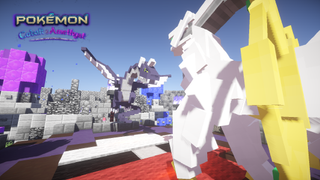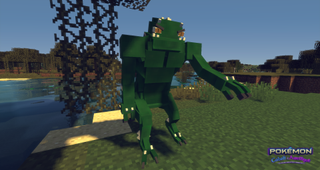
Throwing Pokemon into Minecraft is not a new thing. I mean, heck, there's nothing shocking about seeing mods that insert those dang creatures into any video game. Why wouldn't you do it? They're popular, they're fun, and they sometimes look like big buff dudes like (not) me. However, Pokemon Cobalt & Amethyst developer Phoenix… well, he doesn't quite remember why he started working two-and-a-half years ago on a Minecraft map that works as if it's a new, first-person Pokemon game. All he remembers are the messages and comments of encouragement from fans that kept him going.
Last week, we reported on how Pokemon Cobalt & Amethyst is a map for vanilla Minecraft that doesn't require you to mod the game. But this story starts all the way back in 2014. Phoenix had succeeded at creating Pokemon-like wild battles "using Minecraft's 'tall grass' image," and other YouTubers started to take note, complimenting his work. It was at this point that he wondered if he could create a full-fledged Pokemon game.
"I never really chose to make the game until my viewers started bringing on the encouragement," he told me. "I never thought it was possible."
I never really chose to make the game until my viewers started bringing on the encouragement
The first year of the project was focused entirely on planning and preparation, making sure the buildings and other architecture were constructed just right and that the storyline was ready to be implemented. Throughout development, Phoenix got help from an impressive number of developers within the Minecraft community, which he estimates is at least over a hundred—he told me that if I got a bird's-eye view of the map, I'd understand why so many people were needed.
"The redstone work, or 'coding,' didn't begin until most of that was completed since a lot of the 'coding' requires proximity detection," he explained to me. The second year is when a large portion of that "coding" began, which is when a Minecraft user uses command blocks powered by redstone to make certain actions happen in-game. This is how Pokemon Cobalt & Amethyst is able to produce such a unique experience.
"Redstone coding is basically the 'coding language' used in Minecraft," Phoenix said. "It's done with blocks containing commands/characters all wired together to produce a variety of results. I really have no coding experience, but imagine 'actual' coding, in itself, done visually or physically."

One aspect of the map that used this type of coding was the battle system, which Phoenix says took around six months to get fully ironed out. Despite the large amount of work, he wasn't afraid to admit was also his favourite part.
Comic deals, prizes and latest news
Sign up to get the best content of the week, and great gaming deals, as picked by the editors.
"The idea of being able to replicate a functional Pokemon battle using Minecraft's in-game code is just fascinating," he said. "The battle mechanism requires an intricate system of logic. Converting each nuance, such as damage/EXP calculation and statuses, into the Minecraft command system is, and was, no easy feat. Also bear in mind that the battle system is indirectly related to every other Pokémon mechanic, including move memory and level-up movesets. Completing the entire system was definitely one of my favourite achievements.
"Something else that was almost just as complicated was the PC storage system," Phoenix continued. "Because we're talking about Minecraft here, we were forced to store so much data in such a small, physical space. Nevertheless, finally realizing everything was complete, despite the time it all took, was definitely very satisfying."
The idea of being able to replicate a functional Pokemon battle using Minecraft's in-game code is just fascinating
While Pokemon Cobalt & Amethyst features Arceus—a god Pokemon—quite prominently in its story, the Minecraft map contains 136 original creatures. Phoenix told me that designing them is what took the most time in development; some of them weren't even completed until just days before release.
"The process was almost visceral," he said. "I took ideas from many different places, but the sources of these ideas were definitely pretty abstract… many of the early designs were inspired by the in-game Minecraft creatures, just to keep things native and organic. Often though it's almost like seeing the name and then forming an image in your brain… there was no express method so [we could] maintain the flexibility for team members to come up with their own ideas."
As unique as Cobalt & Amethyst's creatures are, Phoenix did admit to me that they used official sounds from the Pokemon games—you can hear these in the various trailers and videos. On top of that, Nintendo is known to be protective of its intellectual property, having shut down several notable fan projects in the past year. Phoenix says if Nintendo ever did come knocking with a takedown notice, he would simply comply.
As for what Phoenix is going to do next, he told me he's done working on Pokemon Cobalt & Amethyst. While he may continue to help here and there, as he designed many of the map's core functions, development takes its toll—he told me that he "didn't really take any breaks over the 31 months." What's next for the ambitious creator? Well, he's a big fan of chess and baseball, so he may just take a swing at one of those.
"As a person who knows nothing about coding, it seems Minecraft is the most convenient and accessible platform for me right now."
If you're interested in trying Pokemon Cobalt & Amethyst for yourself, you can learn how to set up your Minecraft client and download it here.
Most Popular





